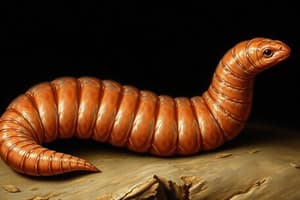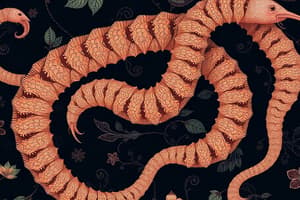Podcast
Questions and Answers
What is the primary reason palolo worms detach their lower halves?
What is the primary reason palolo worms detach their lower halves?
- To escape predators
- To find food in the water column
- To regenerate their bodies
- To release eggs or sperm during mating season (correct)
Which of the following is NOT a characteristic feature of Oligochaeta?
Which of the following is NOT a characteristic feature of Oligochaeta?
- They do not have parapodia
- They have few chaetae
- They possess a distinct head (correct)
- They can live in marine environments
Which of the following organisms is a representative of the subclass Oligochaeta?
Which of the following organisms is a representative of the subclass Oligochaeta?
- Nereis virens
- Palolo viridis
- Eisenia fetida
- Tubifex tubifex (correct)
How quickly can a palolo regenerate its detached portion?
How quickly can a palolo regenerate its detached portion?
Which of the following statements about Oligochaeta is false?
Which of the following statements about Oligochaeta is false?
What characteristic feature distinguishes Annelida from other phyla?
What characteristic feature distinguishes Annelida from other phyla?
Which statement correctly describes the segments of Annelida?
Which statement correctly describes the segments of Annelida?
What is one of the defining features of Class Polychaeta?
What is one of the defining features of Class Polychaeta?
Which of the following organisms is a representative of Class Polychaeta?
Which of the following organisms is a representative of Class Polychaeta?
What is the likely ecological role of Polychaeta in marine environments?
What is the likely ecological role of Polychaeta in marine environments?
Which characteristic is not a feature of Annelida?
Which characteristic is not a feature of Annelida?
During which event do Samoan families typically harvest Palolo worms?
During which event do Samoan families typically harvest Palolo worms?
What flavor profile is commonly associated with Palolo worms when consumed?
What flavor profile is commonly associated with Palolo worms when consumed?
What feature differentiates the locomotion of Polychaetae from Oligochaetae?
What feature differentiates the locomotion of Polychaetae from Oligochaetae?
Which anatomical feature is found in the circulatory system of Oligochaetae?
Which anatomical feature is found in the circulatory system of Oligochaetae?
Which reproductive characteristic is unique to Oligochaetae compared to other Annelida classes?
Which reproductive characteristic is unique to Oligochaetae compared to other Annelida classes?
What is the primary function of metanephridia in Oligochaetae?
What is the primary function of metanephridia in Oligochaetae?
Which of the following features is NOT characteristic of Hirudinea?
Which of the following features is NOT characteristic of Hirudinea?
Which of the following sense organs are commonly found in Polychaetae?
Which of the following sense organs are commonly found in Polychaetae?
What is the mode of gas exchange in Oligochaetae?
What is the mode of gas exchange in Oligochaetae?
Which developmental process is characteristic of Polychaetae?
Which developmental process is characteristic of Polychaetae?
Flashcards
Annelids
Annelids
A group of animals characterized by segmented bodies, a coelom, and bilateral symmetry. They are triploblastic and have a fixed number of segments, each with the same organs.
Chaetae
Chaetae
They are bristles found on the body of annelids, particularly Polychaeta. They help with movement and locomotion.
Polychaeta
Polychaeta
A type of annelid with many bristles. They are predominantly marine and often have a distinct head.
Parapodia
Parapodia
Signup and view all the flashcards
Ragworm (Nereis sp.)
Ragworm (Nereis sp.)
Signup and view all the flashcards
Palolo worm (Palolo viridis)
Palolo worm (Palolo viridis)
Signup and view all the flashcards
Coelom
Coelom
Signup and view all the flashcards
Segmented Animals
Segmented Animals
Signup and view all the flashcards
Oligochaeta
Oligochaeta
Signup and view all the flashcards
Earthworms
Earthworms
Signup and view all the flashcards
Tubifex tubifex
Tubifex tubifex
Signup and view all the flashcards
Megascolides australis
Megascolides australis
Signup and view all the flashcards
Palolo Worm
Palolo Worm
Signup and view all the flashcards
Circular muscles
Circular muscles
Signup and view all the flashcards
Longitudinal muscles
Longitudinal muscles
Signup and view all the flashcards
Metanephridia
Metanephridia
Signup and view all the flashcards
Ladder-like nervous system
Ladder-like nervous system
Signup and view all the flashcards
Palps, tentacles, antennae
Palps, tentacles, antennae
Signup and view all the flashcards
Study Notes
Annelida (Segmented Worms)
- Annelida, meaning "little rings" in Latin, refers to segmented worms.
- Segmented body plan
- Triploblastic (three germ layers)
- Bilaterally symmetrical
- Coelom throughout their lives
Characteristic Features of Annelids
- Segmented bodies: Each segment is similar in structure and contains similar internal organs.
- Metameric segmentation: Each segment is a metamere, and segments are essentially repeated units along the body.
- Triploblastic: Having three germ layers
- Bilaterally symmetrical: Body can be divided into mirror-image halves along a single plane.
Annelida Classification
- Polychaeta (Many bristles): Many bristles (chaetae) on parapodia (lateral projections) which help them to burrow. Primarily marine.
- Representatives: Nereis (ragworm), Palolo viridis (Palolo)
- Oligochaeta (Few bristles): Few bristles (chaetae), no parapodia. Mostly terrestrial or freshwater.
- Representatives: Lumbricus terrestris (earthworm), Tubifex tubifex, Megascolides australis (giant earthworm)
- Hirudinea (Leeches): No bristles, no parapodia, anterior and posterior suckers. Mostly freshwater or terrestrial.
- Representatives: Hirudo medicinalis (medicinal leech)
Characteristic Features of Polychaeta
- Bristles (chaetae) present on parapodia (projections).
- Primarily marine.
- Most have a distinct head.
Characteristic Features of Oligochaeta
- Few or no chaetae.
- No parapodia
- No distinct head
- Mostly terrestrial or freshwater
Characteristic Features of Hirudinea
- No chaetae or parapodia.
- No distinct head
- Suckers on anterior and posterior ends
- Mostly ectoparasites or predators
Annelida Reproduction
- Mostly hermaphrodites (both male and female reproductive organs)
- Some species have separate sexes.
- Polychaetes may have a larval stage (trochophore).
- Many Annelids have direct development.
Annelida Locomotion
- Two types of muscles—circular and longitudinal—used for locomotion.
- Parapodia in Polychaetas—lateral projections on each body segment—aid in movement.
- Few chaetae in Oligochaeta and no parapodia in Hirudinea
- Suckers are used by leeches for movement.
Annelida Habitats
- Polychaetes are mostly marine.
- Some Polychaetes are found in freshwater or brackish areas.
- Oligochaeta: Primarily terrestrial or freshwater.
- Hirudinea: Primarily freshwater or terrestrial.
Other Key Features of Oligochaeta
- Digestive System: Mouth, salivary glands, pharynx, esophagus, crop, gizzard, intestine, and anus.
- Circulatory System: Closed system with dorsal and ventral blood vessels.
Other Key Features of Polychaeta
- Nervous system (ladder-like)
- Sense organs: (Palps, tentacles, antennae, and eyes)
- Excretory system: Metanephridia (pair per segment)
Annelida Benefits
- Earthworms improve soil structure and fertility.
- Certain species (e.g., polychaetes) are food sources.
- Some are used medicinally (e.g., leeches).
Studying That Suits You
Use AI to generate personalized quizzes and flashcards to suit your learning preferences.
Related Documents
Description
Explore the fascinating world of Annelida, the segmented worms, known for their unique body structure and classification. This quiz covers essential features, such as segmentation, symmetry, and the two main classes: Polychaeta and Oligochaeta. Test your knowledge of these intriguing organisms and their characteristics.




